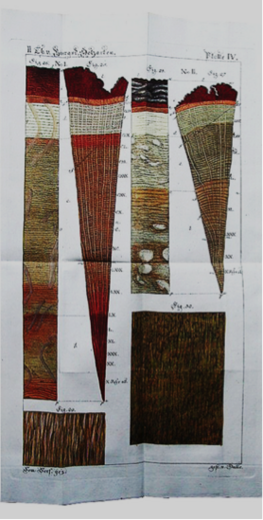Planks

Explore the boat’s hull. Click on the grey areas to read more about the hull’s construction.
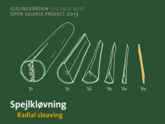
The cleaved plank
The saw was not used when making planks in the Viking Age. Instead, planks were cleaved as illustrated to the right. When cleaving planks for boatbuilding, it is important to find the right tree in the forest with the necessary dimensions and quality. The tree must be straight-growing and knot-free, and it must be big.
The outer sapwood - wich is lighter in colour - rots too quickly and cannot be used, and the centre of the trunk (pith) grows irregularly, so that must also be cut away. Therefore, the tree essentially needs to be oversized. If many broad planks are required, then the diameter must be increased.
In an oak tree, the pith rays (see illustration to the left) extend from the pith to the tree’s outer edge, just like spokes on a bicycle wheel. When oak is cleaved, it splits along both these pith rays and the tree’s own fibres. If the tree is twisted, the cleaving will also follow this twist. Usually, you can tell if the fibres are twisted or straight-growing by looking at the bark.
When boatbuilding, a straight-growing tree is always optimal, as it is easier to produce planks with an even thickness if the cleaved sections aren’t twisted. However, a twisted plank still has the same strength, so long as the fibres are not cut over in an attempt to straighten the plank.
After cleaving, the pieces are roughly shaped with an axe. The planks are then smoothed using a broad-bladed axe, the long edge of which serves to even out the surface of the planks. On some boats, tool marks from axes can be seen while others bear traces of the use of planes. A plank is called a board when it is placed on a boat.
Cleaving oak for the Gislinge Boat's planks
During the spring, the boatbuilders had been in the woods at Vallø to select trees for the Gislinge Boat and at the start of May, an impressive 180 year old oak was delivered to the boatyard, where it lay patiently for the next few weeks as the boatbuilders began working on the keel and stems of the boat.
The keel and stems almost complete, the boatbuilders attention turned to the production of Gislinge Boat’s planks. Although small saw blades dating to the Viking and early Middle Ages have been found archaeologically, sawmarks have never been found on any ship timbers dating from that period. Instead of saws, mallets and wedges were used to cleave timbers and shape the planks, frames and other elements that make up the hull. Cleaving involves the use of wedges, mallets, axes and sheer muscle to split the oak along the line of its fibres, first in half, then quarters, eighths, sixteenths, and occasionally, 32-parts, which are then shaped to form the finished planks.
Big Cleaving Day
Monday 15th June, saw the area around the oak being roped off, as the boatbuilders began to gather the tools they needed for the day and to make the final deliberations before the cleaving could began. Working from the root end, the first cuts for the wedges were made as an axe blade was used to mark the preferred line the boatbuilders had chosen for the split. Small oak wedges were then driven into the oak along this line, forcing the first separation of the oak’s fibres. Simplistic as it sounds, this is essentially the cleaving process in a nutshell: slowly but surely, the wedges are driven further into the end of the trunk and the split begins to penetrate further along the length of the oak.
After 15 minutes, Niels, the apprentice at the boatyard, began to remove the bark along the top of the oak, so the line of the split could be seen more clearly. Martin and Ture then began to increase the size of the oak wedges at the root end and the strikes of the rhythmic strikes of the hammer continued, broken only by the brief pauses taken to stand back and assess the progress of their work. After an hour, Ture began to insert small wedges into the line of the split along the side of the oak, gradually increasing their size as the cleaving continued. Standing atop the oak, Lene used a froe to help separate the fibres along the line of the split.
Hard work and high humour
By this stage, all of the boatbuilders were involved in the cleaving, taking turns to swing the mallets and keep an eye on the progression of the split, as the oak creaked and snapped in protest. Just two hours after they had begun, the end was almost in sight. The midsection had proved to be more stubborn than they had originally expected, slowing progress for a time, but eventually it yielded to the force of the blows. The oak began to ‘talk’ more and more as you could hear the fibres giving way within the trunk. More wedges were inserted into the side of the oak, and with a renewed energy and the support of a growing crowd of spectators, the boatbuilders continued steadily, blow after blow, until the split had finally worked its way along the length of the oak. Some fibres still held on stubbornly, so Martin and Asger took hold of either side of the oak at the root end and rocked it back and forth until it finally gave way (you can see a short clip of the big moment here…).
After a few moments of well-deserved rest, the boatbuilders were back in action again, working on cleaving the first half down to quarters and then eighths.
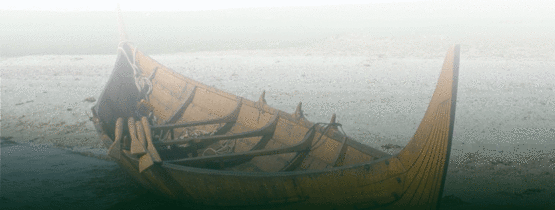

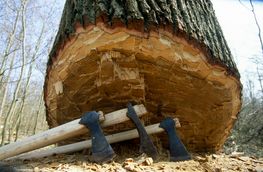
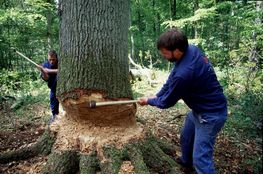
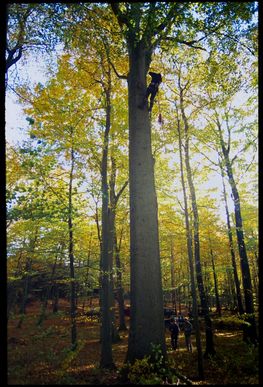
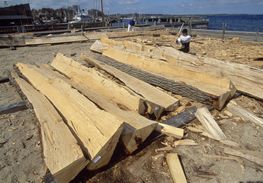

The weaver is hard at work on the square sail
Learn more about the importance of the sail here...

The blacksmith is hand-forging several hundred nails
Learn more about the iron that holds the boat together...
